Liquids/Liquid objects/Astronomy
< Liquids < Liquid objects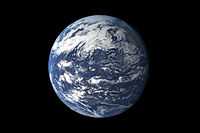
A division of astronomical objects between rocky objects, liquid objects, gaseous objects (including gas giants and stars), and plasma objects may be natural and informative.
The astronomy of such objects may be called liquid-object astronomy.
The image at right is a detailed, photo-like view of Earth based largely on observations from the Moderate Resolution Imaging Spectroradiometer (MODIS) on NASA’s Terra satellite.
Liquids
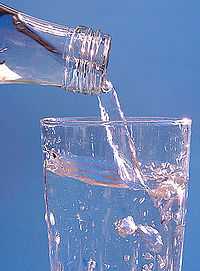
Def. a "substance that is flowing, and keeping no shape, such as water; a substance of which the molecules, while not tending to separate from one another like those of a gas, readily change their relative position, and which therefore retains no definite shape, except that determined by the containing receptacle; an inelastic fluid"[1] is called a liquid.
"The dawn of the oil age was fairly recent. Although the stuff was used to waterproof boats in the Middle East 6,000 years ago, extracting it in earnest began only in 1859 after an oil strike in Pennsylvania. ... It was used to make kerosene, the main fuel for artificial lighting after overfishing led to a shortage of whale blubber. Other liquids produced in the refining process, too unstable or smoky for lamplight, were burned or dumped."[2]
Liquid objects
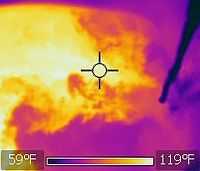
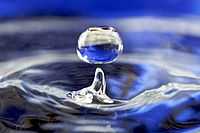
"A liquid is made up of tiny vibrating particles of matter, such as atoms and molecules, held together by intramolecular bonds. ... Although liquid water is abundant on Earth, this state of matter is actually the least common in the known universe, because liquids require a relatively narrow temperature/pressure range to exist."[3]
The first image at right shows liquid water using an infrared detector, but information confirming the presence of liquid water solely from the infrared image is inferred.
The image at left uses a visual radiation detector to record a meteor collision with liquid water.
"Reconstructions of seismic waves in the deep interior of the Earth show that there are no S-waves in the outer core. This indicates that the outer core is liquid, because liquids cannot support shear. The outer core is liquid, and the motion of this highly conductive fluid generates the Earth's field (see geodynamo)."[4]
"When solid or liquid objects formed in the early Solar System, either by condensation from the vapor phase or by melting and crystallization of preexisting material, each of these isotopic chronometers is expected to have been reset."[5]
Earth
"Viewed from space, the most striking feature of our planet is the water. In both liquid and frozen form, it covers 75% of the Earth’s surface. It fills the sky with clouds. Water is practically everywhere on Earth, from inside the rocky crust to inside our cells."[6]
Technology
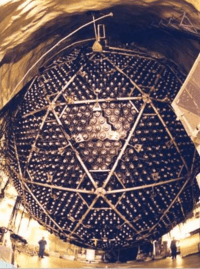
"Condensed noble gases, most notably liquid xenon and liquid argon, are excellent radiation detection media. They can produce two signatures for each particle interaction: a fast flash of light (scintillation) and the local release of charge (ionisation). In two-phase xenon – so called since it involves liquid and gas phases in equilibrium – the scintillation light produced by an interaction in the liquid is detected directly with photomultiplier tubes; the ionisation electrons released at the interaction site are drifted up to the liquid surface under an external electric field, and subsequently emitted into a thin layer of xenon vapour. Once in the gas, they generate a second, larger pulse of light (electroluminescence or proportional scintillation), which is detected by the same array of photomultipliers. These systems are also known as xenon 'emission detectors'.[7]"[8]
“The basic set-up consists of 1600 water tanks (water Cherenkov Detectors, similar to the Haverah Park experiment) distributed over 3,000 square kilometres (1,200 sq mi), along with four atmospheric fluorescence detectors (similar to the High Resolution Fly's Eye) overseeing the surface array.”[9]
“The Pierre Auger Observatory is unique in that it is the first experiment that combines both ground and fluorescence detectors at the same site thus allowing cross-calibration and reduction of systematic effects that may be peculiar to each technique. The Cherenkov detectors use three large photomultiplier tubes to detect the Cherenkov radiation produced by high-energy particles passing through water in the tank. The time of arrival of high-energy particles from the same shower at several tanks is used to calculate the direction of travel of the original particle. The fluorescence detectors are used to track the particle shower's glow on cloudless moonless nights, as it descends through the atmosphere.”[9]
"The bubble chamber ... reveals the tracks of subatomic particles ... as trails of bubbles in a superheated liquid, usually liquid hydrogen. Bubble chambers can be made physically larger than cloud chambers, and since they are filled with much-denser liquid material, they reveal the tracks of much more energetic particles."[10]
"The field of neutrino astronomy is still very much in its infancy – the only confirmed extraterrestrial sources so far are the Sun and supernova SN1987A. Various detection methods have been used. Super Kamiokande is a large volume of water surrounded by phototubes that watch for the Cherenkov radiation emitted when an incoming neutrino creates an electron or muon in the water. The Sudbury Neutrino Observatory is similar, but uses heavy water as the detecting medium. Other detectors have consisted of large volumes of chlorine or gallium which are periodically checked for excesses of argon or germanium, respectively, which are created by neutrinos interacting with the original substance. [...] Borexino uses a liquid pseudocumene scintillator also watched by phototubes while the proposed NOνA detector will use liquid scintillator watched by avalanche photodiodes."[11]
“Scintillation neutron detectors include liquid organic scintillators,[12] crystals,[13][14] plastics, glass[15] and scintillation fibers.[16]”[17]
Research
Hypothesis:
- Liquids in or on astronomical objects and liquid astronomical objects may be twice as common as originally expected in the 1980s.
Control groups

The findings demonstrate a statistically systematic change from the status quo or the control group.
“In the design of experiments, treatments [or special properties or characteristics] are applied to [or observed in] experimental units in the treatment group(s).[18] In comparative experiments, members of the complementary group, the control group, receive either no treatment or a standard treatment.[19]"[20]
Proof of concept
Def. a “short and/or incomplete realization of a certain method or idea to demonstrate its feasibility"[21] is called a proof of concept.
Def. evidence that demonstrates that a concept is possible is called proof of concept.
The proof-of-concept structure consists of
- background,
- procedures,
- findings, and
- interpretation.[22]
See also
References
- ↑ "liquid, In: Wiktionary". San Francisco, California: Wikimedia Foundation, Inc. September 21, 2013. Retrieved 2013-09-30.
- ↑ "Yesterday’s fuel". The Economist 408 (8847). August 3, 2013. http://www.economist.com/news/leaders/21582516-worlds-thirst-oil-could-be-nearing-peak-bad-news-producers-excellent. Retrieved 2013-09-30.
- ↑ "Liquid, In: Wikipedia". San Francisco, California: Wikimedia Foundation, Inc. May 25, 2013. Retrieved 2013-05-26.
- ↑ "Geophysics, In: Wikipedia". San Francisco, California: Wikimedia Foundation, Inc. October 18, 2012. Retrieved 2012-11-16.
- ↑ Donald D. Bogard (May 1995). "Impact ages of meteorites: A synthesis". Meteoritics 30 (05): 244-68. http://adsabs.harvard.edu/full/1995Metic..30..244B. Retrieved 2013-08-02.
- ↑ Robert Simmon and Marit Jentoft-Nilsen (October 2, 2010). "The Water Planet". Washington, DC USA: NASA. Retrieved 2013-05-29.
- ↑ B. A. Dolgoshein, V. N. Lebedenko & B. I. Rodionov, "New method of registration of ionizing-particle tracks in condensed matter", JETP Lett. 11(11): 351 (1970)
- ↑ "ZEPLIN-III, In: Wikipedia". San Francisco, California: Wikimedia Foundation, Inc. May 10, 2013. Retrieved 2013-05-22.
- 1 2 "Pierre Auger Observatory, In: Wikipedia". San Francisco, California: Wikimedia Foundation, Inc. June 10, 2012. Retrieved 2012-06-19.
- ↑ "Cloud chamber, In: Wikipedia". San Francisco, California: Wikimedia Foundation, Inc. April 15, 2013. Retrieved 2013-05-17.
- ↑ "Neutrino detector, In: Wikipedia". San Francisco, California: Wikimedia Foundation, Inc. May 23, 2012. Retrieved 2012-06-19.
- ↑ Yousuke, I.; Daiki, S.; Hirohiko, K.; Nobuhiro, S.; Kenji, I. (2000). "Deterioration of pulse-shape discrimination in liquid organic scintillator at high energies". Nuclear Science Symposium Conference Record, Volume: 1 (IEEE) 1: 6/219–6/221 vol.1. doi:10.1109/NSSMIC.2000.949173. ISBN 0-7803-6503-8.
- ↑ Kawaguchi, N.; Yanagida, T.; Yokota, Y.; Watanabe, K.; Kamada, K.; Fukuda, K.; Suyama, T.; Yoshikawa, A. (2009). "Study of crystal growth and scintillation properties as a neutron detector of 2-inch diameter eu doped LiCaAlF6 single crystal". Nuclear Science Symposium Conference Record (NSS/MIC) (IEEE): 1493–1495. doi:10.1109/NSSMIC.2009.5402299. ISBN 978-1-4244-3961-4.
- ↑ Example crystal scintillator based neutron monitor.
- ↑ Bollinger, L.M.; Thomas, G.E.; Ginther, R.J. (1962). "Neutron Detection With Glass Scintillators". Nuclear Instruments and Methods 17: 97–116.
- ↑ Miyanaga, N.; Ohba, N.; Fujimoto, K. (1997). "Fiber scintillator/streak camera detector for burn history measurement in inertial confinement fusion experiment". Review of Scientific Instruments 68 (1): 621–623. doi:10.1063/1.1147667.
- ↑ "Neutron detection, In: Wikipedia". San Francisco, California: Wikimedia Foundation, Inc. March 17, 2013. Retrieved 2013-05-22.
- ↑ Klaus Hinkelmann, Oscar Kempthorne (2008). Design and Analysis of Experiments, Volume I: Introduction to Experimental Design (2nd ed.). Wiley. ISBN 978-0-471-72756-9. http://books.google.com/?id=T3wWj2kVYZgC&printsec=frontcover.
- ↑ R. A. Bailey (2008). Design of comparative experiments. Cambridge University Press. ISBN 978-0-521-68357-9. http://www.cambridge.org/uk/catalogue/catalogue.asp?isbn=9780521683579.
- ↑ "Treatment and control groups, In: Wikipedia". San Francisco, California: Wikimedia Foundation, Inc. May 18, 2012. Retrieved 2012-05-31.
- ↑ "proof of concept, In: Wiktionary". San Francisco, California: Wikimedia Foundation, Inc. November 10, 2012. Retrieved 2013-01-13.
- ↑ Ginger Lehrman and Ian B Hogue, Sarah Palmer, Cheryl Jennings, Celsa A Spina, Ann Wiegand, Alan L Landay, Robert W Coombs, Douglas D Richman, John W Mellors, John M Coffin, Ronald J Bosch, David M Margolis (August 13, 2005). "Depletion of latent HIV-1 infection in vivo: a proof-of-concept study". Lancet 366 (9485): 549-55. doi:10.1016/S0140-6736(05)67098-5. http://www.sciencedirect.com/science/article/pii/S0140673605670985. Retrieved 2012-05-09.
External links
- African Journals Online
- Bing Advanced search
- Google Books
- Google scholar Advanced Scholar Search
- International Astronomical Union
- JSTOR
- Lycos search
- NASA/IPAC Extragalactic Database - NED
- NASA's National Space Science Data Center
- Office of Scientific & Technical Information
- Questia - The Online Library of Books and Journals
- SAGE journals online
- The SAO/NASA Astrophysics Data System
- Scirus for scientific information only advanced search
- SDSS Quick Look tool: SkyServer
- SIMBAD Astronomical Database
- SIMBAD Web interface, Harvard alternate
- Spacecraft Query at NASA.
- SpringerLink
- Taylor & Francis Online
- Universal coordinate converter
- Wiley Online Library Advanced Search
- Yahoo Advanced Web Search
| ||||||||||||||||||||||||||||||||||||||
![]() This is a research project at http://en.wikiversity.org
This is a research project at http://en.wikiversity.org
| |
Development status: this resource is experimental in nature. |
| |
Educational level: this is a research resource. |
| |
Resource type: this resource is an article. |
| |
Resource type: this resource contains a lecture or lecture notes. |
| |
Subject classification: this is an astronomy resource. |